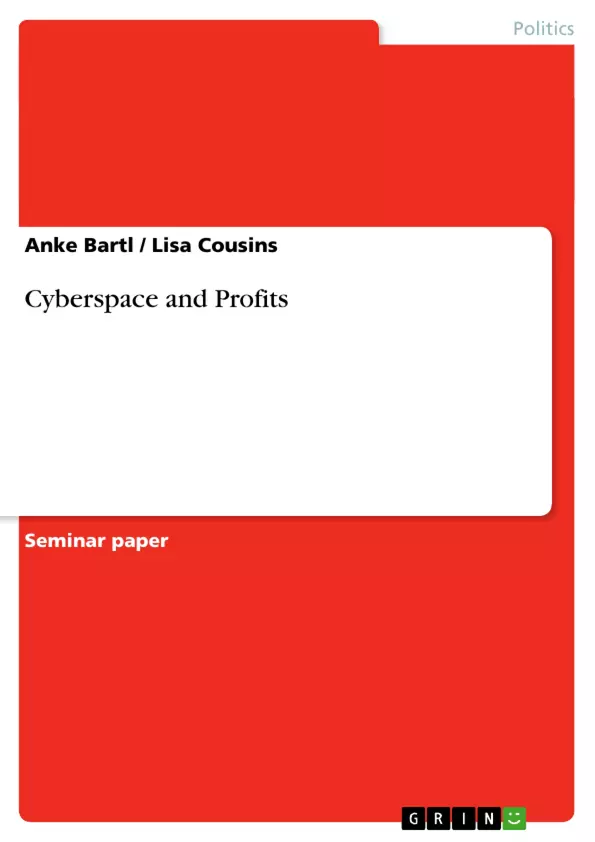With the introduction of the Internet another imaginary world has been created, otherwise
known as “cyberspace”, which has produced an “information revolution”. The world of
cyberspace was developed through the use of a computer network connected via phonelines
throughout the world. The growth of the Internet means that everyone from
anywhere around the world can become a part of the global village and communicate no
matter what their wealth status is. Data is exchanged freely, as there is no longer the
need for circuits; therefore no restrictions apply as to the destination of the data. Through
cyberspace, no rules, structure or true identity exist, as a new identity can be created at
any one time.1 For example, if you were male and wanted to portray yourself as female,
Cyberspace would allow that to happen.
Ever improving communication technologies and globalisation have changed the world
into a global village. The “information revolution” has made it possible for us to instantly
communicate worldwide and therefore has altered our economic behaviour. It is now
possible to do almost anything in cyberspace, and certainly business can be done via the
web and hence profits can be gained or lost.
Howard Rheingold summarised cyberspace as “the conceptual space where words,
human relationships, data, wealth and power are manifested by people using CMC
[computer mediated communications] technology”.2 [...]
1 Martin Dodge & Rob Kitchin, Mapping Cyberspace, Routledge, London, 2001, p.2-5.
2 Howard Rheingold quoted by Brian D. Loader,’ The Governance of Cyberspace:
Politics, Technology and Global Restructuring’, in Brian Loader (ed), The Governance of
Cyberspace: Politics, Technology and Global Restructuring, Routledge, London, 1997,
p.1.
Inhaltsverzeichnis (Table of Contents)
- Introduction
- What is Cyberspace
- Internet usage
- Payment systems and security
- Internet and Business
- Internet Casinos
- Conclusion
Zielsetzung und Themenschwerpunkte (Objectives and Key Themes)
This assignment examines the impact of cyberspace on business and the emergence of profits generated through online activity. It analyzes the development of cyberspace, explores internet usage trends, and discusses the various business opportunities and challenges presented by this new digital landscape.
- The rise and evolution of cyberspace and the "information revolution."
- The growth and demographics of internet users.
- The influence of the internet on global business practices and the potential for profits.
- The challenges and opportunities presented by online payment systems and security.
- The emergence of internet casinos as a unique business sector within cyberspace.
Zusammenfassung der Kapitel (Chapter Summaries)
- Introduction: Introduces the concept of cyberspace and the "information revolution" it has brought about, emphasizing its potential for global business and profit generation.
- What is Cyberspace: Defines cyberspace as a conceptual space where human relationships, data, wealth, and power are manifested through computer-mediated communication (CMC) technologies. It highlights the unique characteristics of cyberspace, such as its anonymity and the ability to create new identities.
- Internet usage: Discusses the growth and demographics of internet users, noting the increasing adoption of the internet for various purposes such as communication, research, and business. It also examines the limitations of internet access, such as affordability and infrastructure requirements.
- Payment systems and security: Explores the challenges and opportunities related to online payment systems and security, emphasizing the need for robust systems to ensure secure financial transactions in cyberspace.
- Internet and Business: Discusses the impact of the internet on global business practices, highlighting the potential for profits and the challenges of operating in a digital environment. It examines the role of online marketing, e-commerce, and other business models emerging within cyberspace.
- Internet Casinos: Focuses on the emergence of internet casinos as a distinct business sector within cyberspace, analyzing their potential and the legal and ethical considerations surrounding online gambling.
Schlüsselwörter (Keywords)
The key terms and concepts explored in this assignment include cyberspace, information revolution, internet usage, global business, online payment systems, security, internet casinos, profits, and computer-mediated communication (CMC).
- Citation du texte
- Anke Bartl (Auteur), Lisa Cousins (Auteur), 2003, Cyberspace and Profits, Munich, GRIN Verlag, https://www.grin.com/document/18824



